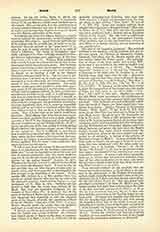

Mariotte, EDME, French physicist, b. at Dijon, France, about 1620; d. at Paris, May 12, 1684. His residence was at Dijon, and some of his works are dated from that place. He was ordained and, as a reward for his successful scientific labors, was made prior of Saint-Martin-sous-Beaune near Dijon. Condorcet remarks on that subject that “no profane use is made of the property of the Church, when it goes to reward services rendered to humanity”. Mariotte is pronounced the first in France to “bring into the study of physics a spirit of observation and of doubt, and to inspire that caution and timidity so necessary to those who question nature and who try to interpret her answers.” In his “Essay on Logic” he enumerates rules of reasoning as well as the fundamental principles themselves, especially in the case of what he calls the natural and the moral sciences. He there teaches a method of experimental research for the establishment of truth, so that we are thus able to study the methods which he used himself to obtain those great results from his experiments.
His fame rests on his work on hydrostatics and on the establishment of the law of gases that bears his name. This was first published in an essay on the nature of air in 1676.”The diminution of the volume of the air proceeds in proportion to the weights with which it is loaded.” This law is now stated as follows: The volume of a gas, kept at a constant temperature, changes inversely as the pressure upon the gas. This is the fundamental generalization of our knowledge concerning gases. He invented a device for proving and illustrating the laws of impact between bodies. The bobs of two pendulums are struck against each other, and the resultant motions are measured and studied. He added to the mathematical deductions of Galileo, Pascal, and others, a number of experimental demonstrations of the laws of the pendulum, of the flow of water through orifices, of hydrostatic pressure etc. Mariotte’s flask is an ingenious device to obtain a uniform flow of water. His work included experiments on heat and cold, light, sight, and color. He was a member of the Royal Society of Science from its foundation in 1666. His contributions (Oeuvres) were collected and published at Leyden in 1717, and again at The Hague in 1740. They include reprints of the following: “Nouvelles decouvertes touchant la vue” (Paris, 1668); “Experiences sur la congelation de l’eau” (Paris, 1682); “Traits du nivellement” (Paris, 1672-4); “Traits de la percussion des corps” (Paris, 1676); “Essais de physique” (4 vols., Paris, 1676-81); “De la vegetation des plantes” (Paris, 1679 and 1686); “De la nature de fair” (Paris, 1679); “Traits des couleurs” (Paris, 1681); “Essai de logique” (Paris, 1678); “Traits du mouvement des eaux et des autres corps fluides” (Paris, 1686; 2nd ed., 1700).
WILLIAM FOX

